Celiac disease is an autoimmune disease caused by an abnormal immune response to gluten peptides in the upper small intestine. It is important to understand its pathophysiology to know how to interpret the serological tests that assist in the diagnosis of celiac disease.
Gluten is a protein found in wheat, barley, and rye. In the small intestine, gluten is digested and breaks down into gliadin.

In celiac disease, gliadin manages to cross the epithelial barrier in the small intestine and reach the underlying lamina propria. The cause of gliadin epithelial permeability is uncertain, but it may be due to an underlying pathological process (for example, infection) or changes in intercellular junctions (tight junctions).
Celiac Disease (CD) results from the interaction of gluten with immune, genetic, and environmental factors.
Immune response in the mucosa
When gliadin comes into contact with the lamina propria, it is deaminated by tissue transglutaminase (TTG). The deaminated gliadin then reacts with HLA-DQ2 or HLA-DQ8 receptors on antigen-presenting cells that stimulate the activation of T and B cells, leading to the release of cytokines, antibody production, and lymphocyte infiltration. Over time, inflammation causes villous atrophy, crypt hyperplasia in epithelial cells, and intraepithelial lymphocytosis.

Genetic Factors
The familial occurrence of celiac disease suggests that there is a genetic influence in its pathogenesis. Celiac disease does not develop unless a person has alleles that encode for the HLA-DQ2 or HLA-DQ8 proteins, products of two of the HLA genes.
However, many people, most of whom do not have celiac disease, carry these alleles; therefore, their presence is necessary, but not sufficient for the development of the disease.
Studies in siblings and identical twins suggest that the contribution of HLA genes to the genetic component of celiac disease is less than 50%.14 Several non-HLA genes that may influence susceptibility to the disease have been identified, but their influence has not been confirmed.
Environmental Factors
Epidemiological studies have suggested that environmental factors play an important role in the development of celiac disease. These include a protective effect of breastfeeding and the introduction of gluten in relation to weaning. Initial administration of gluten before 4 months of age is associated with an increased risk of developing the disease, and the introduction of gluten after 7 months is associated with a marginal risk. However, the overlap of gluten introduction with breastfeeding may be a more important protective factor in minimizing the risk of celiac disease.
The occurrence of certain gastrointestinal infections, such as rotavirus infection, also increases the risk of celiac disease in childhood.
Now understand how the research of autoantibodies can help in the diagnosis of celiac disease: The role of autoantibodies in the diagnosis of celiac disease
References
- Green PH, Cellier C. Celiac disease. N Engl J Med. 2007 Oct 25;357(17):1731-43. doi: 10.1056/NEJMra071600. PMID: 17960014.
- Kaminarskaya Yu?. Celiac disease, wheat allergy, and nonceliac sensitivity to gluten: topical issues of the pathogenesis and diagnosis of gluten-associated diseases. Clinical nutrition and metabolism. 2021;2(3):113–124.
How to Cite this article
Martins BC. Pathogenesis of Celiac Disease. Gastropedia, 2023, vol I. Available at: https://gastropedia.com.br/gastroenterology/intestine/pathogenesis-of-celiac-disease
Professor Livre-Docente pela Faculdade de Medicina da Universidade de São Paulo
Médico Endoscopista do Instituto do Câncer do Estado de São Paulo (ICESP)
Médico Endoscopista do Hospital Alemão Oswaldo Cruz
Emerging Star pela WEO


